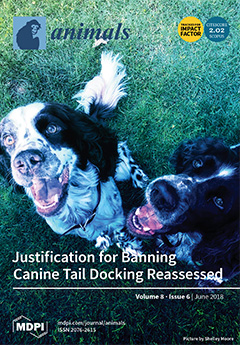The use of feed additives to improve feed conversion while increasing growth is the goal of any broiler nutrition program. Therefore, it is important to evaluate potential feed additives not only for increased performance, but also for any negative attributes. A study was
[...] Read more.
The use of feed additives to improve feed conversion while increasing growth is the goal of any broiler nutrition program. Therefore, it is important to evaluate potential feed additives not only for increased performance, but also for any negative attributes. A study was conducted to evaluate the effects of feeding phosphatidic acid (PA) to broiler chickens. Two experiments were conducted using exercise in conjunction with PA (Experiment 1(E1)) and administering PA at different inclusion rates in the diet (Experiment 2 (E2)); LowPA (5 mg/bird/day), MidPA (10 mg/bird/day), HighPA (15 mg/bird/day), and control (CON). All birds were weighed bi-weekly during the experiments to obtain average pen weights and feed conversion ratios (FCRs). At the end of the experiments, eight birds per pen were processed to evaluate carcass traits and breast yield. In E1, exercise did not affect growth, feed conversion or processing traits (
p > 0.05). However, PA supplementation did increase growth, carcass and breast weight, and carcass and breast yields (
p < 0.05). In E2, differences (
p < 0.05) in live bird weights between the control birds (1.65 kg) and all PA treatments (pooled mean: 1.73 kg) began at 28 days; however, only the LowPA carried that effect (
p = 0.05) through to the conclusion of the trial (3.55 vs. 3.81 kg). Overall, LowPA (1.64) and MidPA (1.69) had lower (
p < 0.05) FCRs than the CON treatment (1.74). Increased growth observed in live bird weights in the LowPA translated to increased (
p < 0.05) overall carcass weights (2.78 vs. 2.99 kg) and specifically breast filet weights (0.69 vs. 0.76 kg). Yields did not differ (
p > 0.05), but with the increased weight feeding LowPA resulted in more total breast meat. Phosphatidic acid did not affect (
p > 0.05) woody breast or white striping. In conclusion, dietary PA improved FCR, increased live bird weights, and increased breast fillet weight without increased incidence of white striping. These results indicate that feeding PA may increase production efficiency in broilers.
Full article






